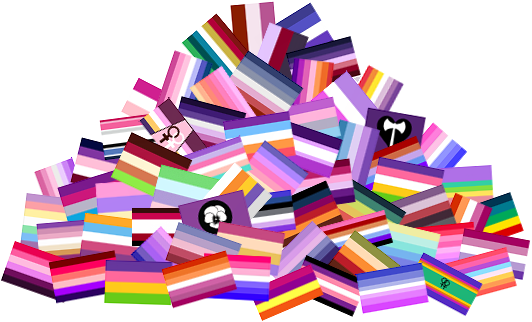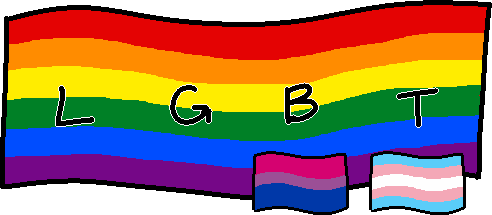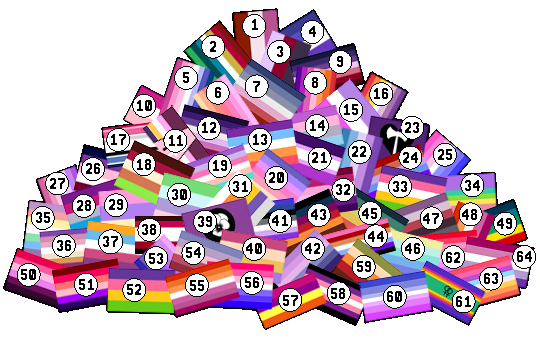 The Labrys Flag
The Labrys Flag“How did we get here?”
 The Labrys Flag
The Labrys FlagSean Campbell, a gay man in the leather scene, designs a series of pride flags for LGBT sub-communities to publish in a 2000 pride edition of the Gay and Lesbian Times (Palm Springs). "The Labrys Flag" is one of these.
A blog titled "The Queerstory Files" publishes Sean's flags with descriptions. Possibly its first appearance online.[1] The blog describes the flag as follows:
This is composed entirely of established symbols. The colour lavender has been used by and for the lgbt community for many decades. … The black triangle was used by the Nazis … [and] covered several so-called “anti-social” groups which included lesbians. … [It] has been used by lesbian and women’s rights groups many times. Sean’s flag design also turns the symbol into a positive affirmation of female power by placing the double-edged axe, the labrys, firmly on top of the triangle. The labrys was an ancient symbol of matriarchal power in the eastern Mediterranean…
Following this, it appears in some pride flag compilations, possibly starting with Clare Bayley's 2013 "A Field Guide to Pride Flags", which also featured his Drag Pride flag.[2][3]
Outside of that, there's no sign Sean's flag was ever widely used or known of.
Meanwhile…
 The Lipstick Lesbian Flag
The Lipstick Lesbian Flag"The Official Lipstick Lesbian Flag" is created by Natalie McCray, and posted on her Wordpress "This Lesbian Life", with the following announcement:[5]
The gay community has so many flags that represent all the different sub-communities. Our gay male friends are definitely the most established. They have a flag for the young gays, leather guys, hairy guys, and girly guys. Even the bisexuals have their own flag!!!!
So I’ve always wondered…WHERE ARE THE LESBIAN FLAGS???? Are we lacking pride or is our community just too lazy to come up with something?
I have taken it upon myself to design the very first lipstick lesbian pride flag. Now we have our own flag to wave at the gay parade!
 The flag's seven-stripe gradient and corner symbol was likely inspired by the flags for the bear and leather subcultures, designed in 1995 and 1989 respectively.
The flag's seven-stripe gradient and corner symbol was likely inspired by the flags for the bear and leather subcultures, designed in 1995 and 1989 respectively.
Natalie uploads her own design to Wikipedia under the name "Nmdesigns",[6] and adds it to the article entitled "Lipstick Lesbian".[7]
A Wikipedia user adds a large number of flags to the "LGBT Symbols" article, including this one.[8]
This increases its profile, and it appears in a number of pride flag compilations.[2][3][9][10]
Natalie plans to sell merchandise using her design, but doesn't follow through.[11][12]
 The Pink Flag
The Pink FlagTumblr user @trans-wife posts this pride flag compilation[archive], featuring a square rendition of the pink flag. Note that including the lipstick symbol could look awkward on a square. @trans-wife posts no other flags with symbols – is she removing the lipstick herself for aesthetic purposes, or is she cropping an already-lipstickless flag down to size?
Pride-Flags,[13] a DeviantArt account run by multiple people that posted many high resolution pride flags every day (mostly for user-submitted microidentities),[14] posts its first 2 lesbian flags on the same day: October 7, 2015.[15][16]
This is not the earliest recorded instance of “The Pink Flag” – the Lipstick flag without the kiss symbol. It likely was not included because its complexity made it too difficult or time-consuming to create a vector for high resolution.
They later admit this was the case:[15]
No I don't [have the lipstick lesbian flag] yet, I've been putting it off because I'd have to redraw the lips since I don't think theres a vector I can use 🙁 I'll see if I can find someone to redraw it for me though!
A year later they would upload the original, with help from someone outside their team.[17]
Possibly Previously thought to be the earliest appearance of the pink flag on Tumblr.[18] It is identical to the image posted by Pride-Flags, and likely not an independent edit, due to its aspect ratio of 1:1.667 (resolution 1280 × 768). The original flag was 1892 × 1204 pixels, with a 1:1.571 aspect ratio. The flag posted on Pride-Flags was 5000 × 3000 pixels, with a 1:1.667 aspect ratio.
While it doesn't gain much traction, it introduces the flag to a new audience. One blogger, having seen it for the first time in this post,[19] would later reblog a slightly reworded version of it.[20]
This new post, using the same image, launches the pink flag into the Tumblr "mainstream", with 82784 notes (a measure of user interactions). The wording of the post—the lesbian flag is so pretty why don’t we use it more
—suggests that this is "the" lesbian flag, which leads most people to believe that it is an established community flag.
Many people were dissatisfied with the pink flag, and the Labrys flag is unearthed as an alternative. However, both flags receive their share of criticisms.
The first attempted lesbian flag redesign is posted to Tumblr.[21] This inspires many others to do the same.
As the critcisms become more widely known,[27] redesigns flood Tumblr, as do attempts to catalogue them all and polls to find a "winning design". Most are based on the pink flag.[22][23][24][25][26]

There is no "official" lesbian flag. At this point, reaching a consensus is unlikely.
Maybe insular lesbian communities will settle on one, but that doesn't amount to a universal lesbian flag.
That's not necessarily a bad thing, though. We have other symbols of pride. The lesbians who came before us were loud and proud through other means.
As for merch?
Sometimes I think we forget that Gilbert Baker made the rainbow flag for us too.

Tumblr user @deadicateddeath points out the existence of this pride flag compilation post on Tumblr [archive], published 8 December 2013. This is now, to my knowledge, the earliest record of the pink stripes featured without the kiss mark. The same blog made another post (10 January 2014) which featured the pink flag and claimed that it was seeing use at the time.
This essay's author is extremely interested in any other evidence of pre-2015 use of the pink flag outside of this blog – if you have any sources, please send them their way!
The goal of this essay was to clear up misinformation, not to tell anyone what flag to use. Use your own judgement, even make your own if you want, just don’t get stressed out if your flag isn’t “the” flag and remember that flag colours are not the only avenue through which to show pride!
There is no evidence to support this. The lipstick lesbian flag had been documented online for years prior to the pink flag, as explained above.
There’s no proof of this – as explained above, the first instance of the mark being “removed” (i.e. not included) was due to it being too complex to easily convert into a high resolution image.
The pink flag has only been in semi-common usage since 2016, and its use is still mostly confined to younger online communities.
The rainbow flag[32] was created by Gilbert Baker in 1978 to represent the LGBT community as a whole (his original 8-stripe design appears at the end of the essay). It does not belong exclusively to gay men, and it does represent lesbians. Please stop framing it like this:

when it’s actually like this:

This doesn’t mean we can’t have a specific flag for the lesbian community, but it’s not the case that we need to scramble the fill the gap left by a “missing” flag.
No readily-accessible information on Sean Campbell suggests this, and while a cursory browse through Natalie McCray’s social media did turn up some casual cissexism, nothing indicates she was a TERF. If you have sources that show otherwise, please send them to the author.
A feminine lesbian, and by many definitions, one who only dates other feminine lesbians. Natalie McCray’s edits to the Lipstick Lesbian Wikipedia page under the name “Nmdesigns”[7] show that she subscribed to the femme4femme definition.
The author doesn’t mind who shares this, and neither does the editor, but if you want to add commentary as someone ouside the lesbian community, especially in the notes of the original Tumblr post, the author requests that you think carefully on whether or not it is relevant or appropriate.
We don’t mind, but we’d strongly recommend including a link back to the original post in order to preserve the sources.
As the author said in the essay: Maybe insular lesbian communities will settle on one, but that doesn't amount to a universal lesbian flag.
Pixellari by Zacchary Dempsey-Plante [dafont.com] is used in the original visual essay. This version merely uses your browser's default font. On many browsers this will be Times New Roman or Arial, both by Monotype.
Note that this is by no means an exhaustive list of recent redesigns, nor will it be. The author is having difficulty tracking down the original posts for flags 17 and 31. If you recognise them, please get in touch!

An asterisk * indicates that the original post has been deleted, and a reblogged version of it has been archived instead.